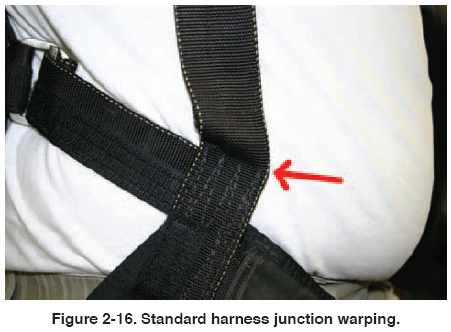Chapter 2
HARNESS DESIGN
According to Poynter’s Parachute Manual, “the harness
is an arrangement of cotton, linen, nylon, or Dacron®
webbing, which is designed to conform to the shape of
the load (usually the body) to be carried in order to secure
it properly so that the opening forces and the weight of
the load are evenly distributed during opening and
descent.”
The earliest harness was nothing more than a swing seat
that the parachutist sat on and then held onto the risers
or suspension straps. It soon became apparent that if the
openings were anywhere uneven, it could be very precarious
for the parachutist. While the sling seat worked
for the ride down, it was necessary to add additional
straps to secure the parachutist. These straps included
the leg, back, and chest straps. The standard harness
configuration is equipped to secure a torso, head, arms
and legs with straps. Others have been added over time for additional purposes such as survival kits or cushions.
Figure 2-12 shows a basic military style harness. This
harness configuration has seven points of adjustment to
allow fitting of most military personnel.

Most of the early parachute systems had the harness
detachable from the containers. This allowed interchangeability
for various models. In the 1970s, skydiving
systems began to integrate the harness into a true harness/
container assembly. This was accomplished by
sandwiching the harness between the container and
backpad and sewing them together. Figure 2-13 shows
one of the earliest custom systems called the “Super
Swooper.” This harness was the precursor of today’s sport
harnesses.

As skydiving and the sport parachute industry has grown,
most of the equipment is now custom-built for each individual.
The standard piggyback harness configuration of
today is a fixed main lift web with adjustments only at
the chest and leg straps. [Figure 2-14] Elimination of the
extra hardware and webbing has resulted in a dramatic
reduction in weight of modern systems. Along with this
has been an increase in comfort and flexibility. One of
the most innovative designs adopted in recent years is the
“articulated” harness. This design incorporates metal
rings at the hip junction and the chest-strap attachment. [Figure 2-15] These rings allow a full range of motion both in the air and on the ground and increase the fit and
comfort of the harness. An added benefit is that this style
of harness is stronger under high shock loads. This is due
to the natural alignment of the webbing during the opening
process. With a nonarticulated harness, the webbing
junctions warp and load unevenly. [Figure 2-16] Because
of this, point loading occurs, stitching breaks, and the
junction can fail with disastrous results.
 
both in the air and on the ground and increase the fit and
comfort of the harness. An added benefit is that this style
of harness is stronger under high shock loads. This is due
to the natural alignment of the webbing during the opening
process. With a nonarticulated harness, the webbing
junctions warp and load unevenly. [Figure 2-16] Because
of this, point loading occurs, stitching breaks, and the
junction can fail with disastrous results.
In recent years and with the increasing popularity of vertical
skydiving or “freeflying,” greater speeds are experienced with corresponding higher loads on the harnesses.
For many years, harnesses were overbuilt as they were
basically copies of military designs. As the sport has progressed,
equipment has been made lighter and smaller.

| 
